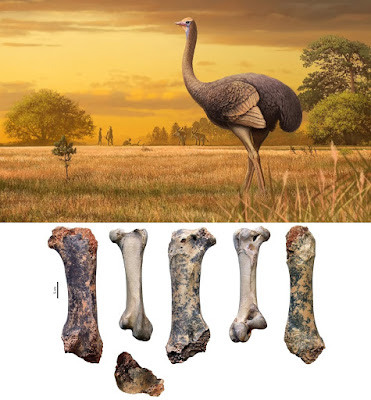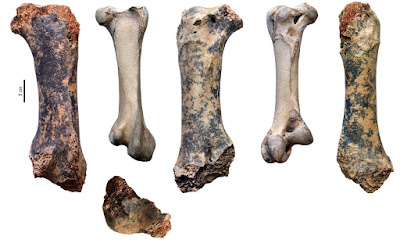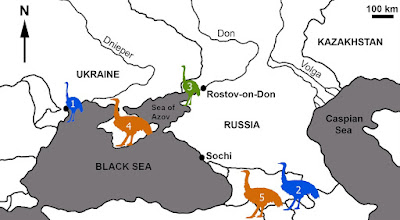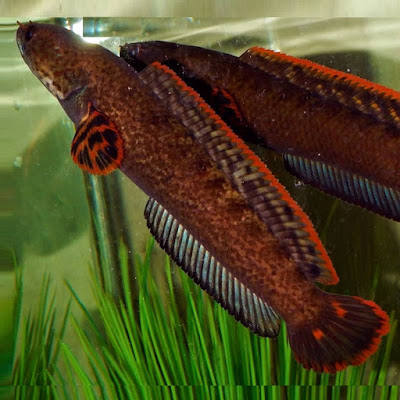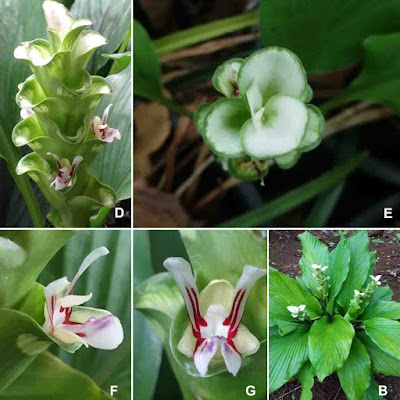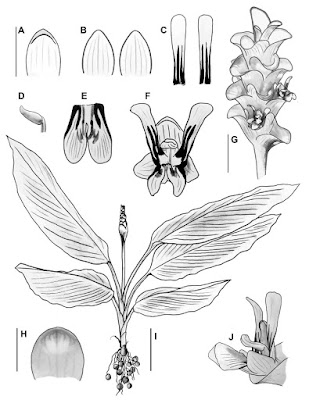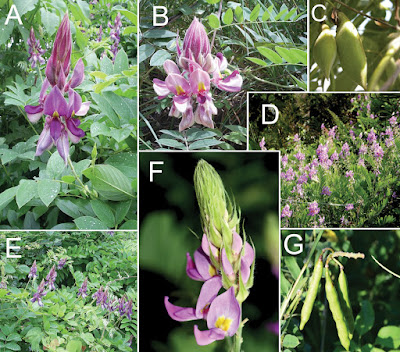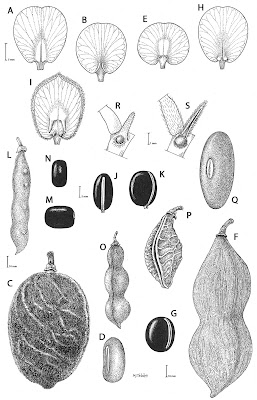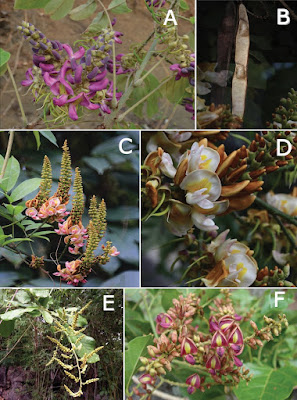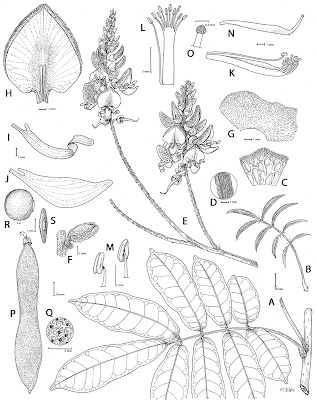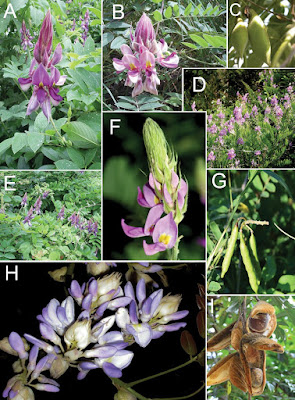[Most Recent Entries] [Calendar View]
Thursday, June 27th, 2019
| Time | Event | ||||||
| 3:07a | [PaleoOrnithology • 2019] Pachystruthio dmanisensis • A Giant early Pleistocene Bird from eastern Europe: Unexpected Component of Terrestrial Faunas at the Time of early Homo arrival
ABSTRACT Giant birds, comparable in size to elephant birds and moa, have never been reported from Europe. Here, we describe a femur from the lower Pleistocene of the north Black Sea area (Crimea) that is referred to Pachystruthio dmanisensis, comb. nov., a giant bird with an estimated body mass of about 450 kg. This value makes this extinct bird one of the largest known avians (comparable to Aepyornis maximus) and the only bird of such giant size in Europe and the Northern Hemisphere in general. In contrast to very large insular birds, Pachystruthio dmanisensis was a good runner, which may be explained by its coexistence with large carnivoran mammals. Pachystruthio dmanisensis and associated assemblage of fossil mammals are shared with the Dmanisi locality in Georgia (∼1.8–1.7 Ma); thus, this giant bird was likely a typical component of eastern European faunas at the time of early hominin arrival. We suggest that Pachystruthio dmanisensis, together with early Homo and a variety of mammals, reached the northern Black Sea region via the southern Caucasus and Anatolia, because the older (Pliocene) finds of this fauna are known from Georgia and Turkey.
SYSTEMATIC PALEONTOLOGY Order ?STRUTHIONIFORMES Family INCERTAE SEDIS Genus PACHYSTRUTHIO Kretzoi, 1954 ?PACHYSTRUTHIO DMANISENSIS (Burchak-Abramovich and Vekua, 1990), comb. nov. Nikita V. Zelenkov, Alexander V. Lavrov, Dmitry B. Startsev, Innessa A. Vislobokova and Alexey V. Lopatin. 2019. A Giant early Pleistocene Bird from eastern Europe: Unexpected Component of Terrestrial Faunas at the Time of early Homo arrival. Journal of Vertebrate Paleontology. e1605521 DOI: 10.1080/02724634.2019.1605521 Half-tonne birds may have roamed Europe at same time as humans theguardian.com/science/2019/jun/27/half-t | ||||||
| 3:37a | [Ichthyology • 2019] Channa brunnea • A New Species of Snakehead (Teleostei: Channidae) from West Bengal, India
Abstract Channa brunnea, a new species of snakehead fish lacking pelvic fins, from West Bengal, India, is distinguished from its pelvic fin-less congeners by possessing an uniform dark brown body, ochre to bright-orange blotches on the caudal fin, fewer dorsal and anal-fin rays (35–37 vs. 47–51 and 24 vs. 28–32, respectively), fewer vertebrae (43 vs. 45–57), and fewer lateral-line scales (43–46 vs. 51–63). Though Channa brunnea superficially resembles C. bleheri, it can be distinguished from the latter by possessing dark-brown oblique markings on the upper half of the body; transverse scale rows (4½–5½ vs. 3½); pre-anal scales (22–26 vs. 17–20); 2 rows of teeth in the fifth ceratobranchial, the outer row with 16 large conical teeth (vs. 3 rows of teeth, the outer row with 13 large conical teeth); dentary with 20 large, stout, conical teeth in the inner row (vs. 32 medium-sized conical teeth); and a Kimura’s two parameter (K2P) distance of 9.8–10.6%. Keywords: Pisces, Channa bleheri, Channa andrao, cox1 gene, Eastern Himalaya, freshwater fish Jayasimhan Praveenraj, Arumugam Uma, Nallathambi Moulitharan and Rajesh Kannan. 2019. Channa brunnea, A New Species of Snakehead (Teleostei: Channidae) from West Bengal, India. Zootaxa. 4624(1); 59–70. DOI: 10.11646/zootaxa.4624.1.4 | ||||||
| 6:04a | [Botany • 2019] Curcuma saraburiensis (Zingiberaceae) • A New Species from Thailand
Abstract Curcuma saraburiensis sp. nov. (Zingiberaceae), a new species from Saraburi Province, Central Thailand, is described, illustrated and photographed. The dominant characteristics of this species are; the fertile bracts are light green with light pale green or white longitudinal line and 2 white circles patch. Coma bracts; outer glabrous, light green with green longitudinal line alternating with light green or white lines, inner glabrous, white with green edges. Lateral staminodes narrowly oblong, white with 3‒4 red lines (2 red lines in the middle, half of the length of the staminodes and 1‒2 lines found at the edge of the staminodes). Labellum obovate, deep incision up to 9 mm, white with 2 purple patches on ether sides and 4 red lines, 2 lines at each side. Keyword: Curcuma saraburiensis, New species, Saraburi, Thailand, Zingiberaceae Curcuma saraburiensis Boonma & Saensouk, sp. nov. Etymology: The specific epithet of the new species is collected from ‘Saraburi Province’, the first discover place. Distribution: Endemic to Thailand, currently found in the type locality (Phra Phutthabat District, Saraburi Province) Ecology: Deciduous forest 50‒300 m above sea level. Vernacular names: "Saraburi-Rum-Luek - สระบุรีรำลึก” DISSCUSION: When comparing all Curcuma L. species reported in previous study by Sirirugsa et al. (2007) and many botanists, the morphology of Curcuma saraburiensis sp. nov. was similar to C. parviflora, C. larsenii and C. rhabdota in some characters but differs in its fertile bracts are light green with light pale green or white longitudinal line and 2 white circles patch. Coma bracts; outer glabrous, light green with green longitudinal line alternating with light green or white lines, inner glabrous, white with green edges. Lateral staminodes narrowly oblong, white with 3-4 red lines. Labellum obovate, deep incision up to 9 mm, white with 2 purple patches on ether sides and 4 red lines, 2 lines at each side. (Table 1 and Figs. 1‒2). Thawatphong Boonma and Surapon Saensouk. 2019. Curcuma saraburiensis (Zingiberaceae), A New Species from Thailand. Taiwania. 64(3); 245-248. DOI: 10.6165/tai.2019.64.245 | ||||||
| 9:35a | [Herpetology • 2019] Platypelis ando • A New Yellow-toed Platypelis Species (Microhylidae, Cophylinae) from the Maroantsetra Region, northeastern Madagascar
Abstract We describe a new species of arboreal narrow-mouthed frog, genus Platypelis, from Ambodivoangy near Maroantsetra in northeastern Madagascar. The new species, Platypelis ando sp. nov., is characterised by small body size (under 19 mm), a generally rather slender body, yellowish finger and toe tips, and a dark brown dorsal chevron. Its advertisement call is a single, moderately long, high-pitched whistle repeated at regular intervals. It is the sister species of P. ravus from Marojejy National Park, but differs from that species by considerable pairwise genetic distances (7.9%) in a fragment of the mitochondrial 16S rRNA gene, and also in bioacoustic and morphological features, especially the absence of yellow on the posterior abdomen. It is also surprisingly similar in external appearance to Cophyla occultans and C. maharipeo, to which it is not, however, closely related; these species are most easily discerned based on their calls. Platypelis ando sp. nov. joins the ranks of several species recently described from Ambodivoangy with close affiliations to species in the nearby Marojejy National Park, that are still divergent at species level. The species qualifies as Critically Endangered according to the IUCN Red List criteria, in line with other species recently assessed from this area, but we urge that more research be conducted in the nearby forests to extend the range of this and other species known only from Ambodivoangy. Key Words: Amphibia, bioacoustics, systematics, taxonomy, morphology, molecular genetics
Platypelis ando sp. nov. Diagnosis: The new species is assigned to the genus Platypelis based on molecular phylogenetic relationships (Fig. 1). Platypelis ando sp. nov. is characterised by the following combination of characters: (1) Small size, with adult male SVL 16.9–18.7 mm; (2) manus with second finger shorter than fourth, pes with fifth toe shorter than third; (3) discs of fingers and toes yellowish to orangish in life; (4) presence of a dark dorsal chevron; (5) presence of dorsal tubercles; (6) short supratympanic dark brown marking; (7) males with prepollical tubercle but lacking a finger-like prepollex as typical for Anodonthyla Müller, 1892. The new species is distinguished from Platypelis cowanii, P. mavomavo, P. grandis, P. tsaratananaensis, P. pollicaris, P. alticola, P. olgae, P. tuberifera, P. barbouri and P. milloti by considerably smaller size (16.9–18.7 vs >25 mm). Among Platypelis species of similar size, it can be distinguished from P. tetra by its smaller dorsal tubercles, absence of large white spots on the dorsum (vs presence), and presence of a brown chevron-shaped marking on the dorsum (vs absence); and from P. karenae by its brown colouration and dorsal patterning (vs yellow colouration and lack of dorsal patterning), short supratympanic dark brown marking (vs extended along the flank), and less pointed snout. Morphologically and genetically, P. ando sp. nov. most closely resembles P. ravus. It differs from that species in the lack of yellowish colour on its venter (vs present), yellowish to orangish dorsal finger and toe tip colouration (vs brownish), and by a chevron-shaped brown marking on dorsum (vs W-shaped). ....
Natural history: As is typical for Platypelis species, calling activity was only heard after dusk. ZSM 291/2010 was found calling 1.8 m above the ground. Nothing further is known about the habits of this species, but based on the reproductive ecology of congeners, it is likely to reproduce in phytotelms and have endotrophic nidicolous tadpoles. Available names: Only two available synonyms of any Cophyla or Platypelis refer to small-sized species that could possibly refer to our new species. Cophyla tuberculata Ahl, 1929 ‘1928’ is currently a synonym of P. grandis. The two syntypes are juveniles according to Blommers-Schlösser and Blanc (1991), but have an SVL of 26 mm, and are therefore larger than the new species. Paracophyla tuberculata Millot & Guibé, 1951 is currently considered a synonym of P. barbouri. The holotype of that species, MNHN-RA-1957.715, differs from our new species in having a more rugose dorsum, broader finger discs, and a darker venter. Additionally, it is from Périnet (=Analamazaotra) in the Central East of Madagascar, more than 400 km south of Ambodivoangy. Blommers-Schlösser and Blanc (1991) concluded that it is conspecific with P. barbouri, and we agree that it is a member of that species complex, which is in need of revision. Etymology: We dedicate this species to our friend and colleague, Dr. Andolalao Rakotoarison, in recognition of her valuable contributions to the systematics and taxonomy of the Malagasy microhylid fauna. The name is to be treated as an invariable noun in the nominative singular. Distribution: The new species is reliably known only from the type locality Ambodivoangy, but the species is likely to be more widespread in low altitude forest of the adjacent Makira Natural Park. Glaw and Vences (1992) found a small Platypelis species (assigned to and figured as P. occultans) near Voloina (15.5775S, 49.6042S; voucher specimens ZFMK 52777–52779), ca. 30 km south of the type locality with similar calls and morphology, which is possibly conspecific with Platypelis ando, but further studies are necessary to confirm its identity. Mark D. Scherz, Jörn Köhler, Miguel Vences and Frank Glaw. 2019. A New Yellow-toed Platypelis Species (Anura, Microhylidae, Cophylinae) from the Maroantsetra Region, northeastern Madagascar. Evolutionary Systematics. 3(1): 75-83. DOI: 10.3897/evolsyst..33417 | ||||||
| 10:14a | [Botany • 2019] The Callerya Group Redefined and Tribe Wisterieae (Fabaceae) Emended based on Morphology and Data from Nuclear and Chloroplast DNA Sequences Abstract The Tribe Wisterieae (Zhu 1994), founded on the single genus Wisteria, is emended and recircumscribed based on morphology and data from nuclear ITS and ndhJ-trnF, matK and rbcL chloroplast DNA sequences. This newly enlarged tribe comprises 36 species and 9 infraspecific taxa within 13 described genera. Six genera are new, two are reinstated and five were previously placed in Tribe Millettieae. The genus Adinobotrys is also reinstated comprising two species including the new combination A. vastus. Other reinstated genera include Whitfordiodendron, with four species, and Padbruggea, with three species, including the reinstatement of P. filipes and the new combination P. filipes var. tomentosa. The existing genera Afgekia, Callerya, Endosamara (with the new combination E. racemosa var. pallida), Sarcodum and Wisteria, with the new combinations W. frutescens subsp. macrostachya are evaluated. The new genera comprise three Australasian species in Austrocallerya: A. australis, A. megasperma and A. pilipes; Wisteriopsis with five species from east Asia has six new combinations: W. japonica, W. kiangsiensis, W. championii, W. eurybotrya, W. reticulata and W. reticulata var. stenophylla. Two species comprise the new Thai genus Kanburia: K. tenasserimensis and K. chlorantha. Nanhaia comprises the two species: N. fordii and N. speciosa and the monotypic genera Sigmoidala and Serawaia are based respectively on the species S. kityana and S. strobilifera. Lectotypes are designated for the names Adinobotrys filipes, A. myrianthus, Millettia bonatiana, Millettia bracteosa, Millettia championii, Millettia cinerea, Millettia dielsiana, Millettia kityana, M. maingayi, Millettia nitida, Millettia oocarpa, Millettiapurpurea, M. reticulata, M. reticulata var. stenophylla, Padbruggea dasyphylla, Pterocarpus australis, Robinia racemosa, Whitfordiodendron scandens, W. sumatranum and Wisteria pallida. A neotype is designated for the name Millettia leiogyna. Keywords: Tribe Wisterieae emended, Leguminosae, new genera, Austrocallerya, Kanburia, Nanhaia, Serawaia, Sigmoidala, Wisteriopsis, molecular phylogeny, morphological key James A. Compton, Brian D. Schrire, Kálmán Könyves, Félix Forest, Panagiota Malakasi, Sawai Mattapha and Yotsawate Sirichamorn. 2019. The Callerya Group Redefined and Tribe Wisterieae (Fabaceae) Emended based on Morphology and Data from Nuclear and Chloroplast DNA Sequences. PhytoKeys. 125: 1-112. DOI: 10.3897/phytokeys.125.34877 |
| << Previous Day |
2019/06/27 [Calendar] |
Next Day >> |
